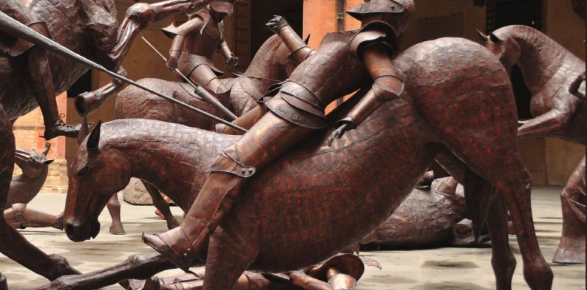
Who is not fascinated by knights in shining armor? Their images continue to attract us to dramatic films, to museum exhibits of elaborate armor and weaponry, or to the showmanship of staged jousts at “Renaissance Fairs”. And we easily think that we understand the ideals of chivalry animating the historical ancestors of these figures in armor. These are “the good guys” of the medieval scene; chivalry made men always “fight fair,” made them polite and respectful to women, and led them selflessly to support only righteous causes.
Medieval Chivalry argues that so simplistic and idealistic a view is not authentically medieval, not the way these elite warriors practiced their profession, nor the way they thought about and debated it over generous goblets of wine in a great hall or around a campfire. The book seeks to recover what chivalry meant from the knights’ own point of view. It shows that modern romantic views came especially from desires in the nineteenth century to reform males. Potentially threatening male vigor might be safely channeled by reviving (and re-inventing) chivalry. My book puts chivalry squarely back into the crucial historical context of its own medieval time-period as a tough and pragmatic warrior code. It argues that chivalry valorized the profession and made its tough practice possible and profitable.
This approach scarcely makes chivalry less important. Never did chivalry rest on merely superficial or frivolous gestures. It was thoroughly hard-headed and it fit the hard warrior profession into medieval life; indeed, chivalry formed one of the fundamental structural elements of that life. Through chivalric ideals a lay elite made sense of violence and ravaging, negotiated the restrictive roles of governance confronting claims of proud independence, incorporated crucial religious piety, portrayed intense male friendship and lauded heterosexual love; it explained status and acquisition of wealth.
Studying chivalry over several decades of my adult life has happily taken me into fascinating corners of medieval civilization, with basic questions continually being unearthed. Are there boundaries between licit and illicit violence? Were women in general beneficiaries of chivalric notions or were they more likely to become victims? How could merciful principles of medieval Christianity (such as those forming the Sermon on the Mount) be squared with the hard, violent, and destructive warrior profession? What can the self-representation of the knights on their seals (used to authenticate documents) and the memorials in brass or stone placed over their tombs tell us?
Confronting this plenitude of puzzles I have found the study of chivalry so fascinating for so long. Its practices were indeed colorful and sometimes quaint, but behind the plumes and pageantry and above the roar of spectators at tournament fields we cannot miss the close discussion about basic values and life and death issues.
Latest Comments
Have your say!